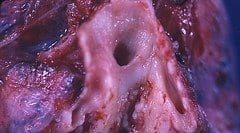Will likely provide a valuable alternative to traditional therapies focused entirely on killing tumor cells
Researchers at Moffitt Cancer Center and colleagues at Wayne State University School of Medicine investigated the acidity in solid tumors to determine if pH levels play a role in cancer cell invasion in surrounding tissues. They found that an acidic microenvironment can drive cancer cells to spread and propose that neutralizing pH would inhibit further invasion, providing a therapeutic opportunity to slow the progression of cancers.
Their study appeared in the Jan. 3 online release of Cancer Research, a publication of the American Association for Cancer Research.
According to the study’s corresponding author, Robert J. Gillies, Ph.D., chair of the Department of Cancer Imaging & Metabolism at Moffitt, acidity in solid tumors is the result of an increased fermentative metabolism combined with poor delivery of blood to tissues.
In this study, tumor invasion and pH were monitored in immunodeficient laboratory mice hosting a variety of tumors. “We monitored the test animals over time using microscopy and found that the highest regions of tumor invasion corresponded to areas with the lowest pH,” Gillies explained. “Tumor invasion did not occur in regions with normal or near normal pH levels. Furthermore, when we neutralized the acidity with oral sodium bicarbonate, the invasion was halted.”
Researchers proposed that the acidic pH of the tumor microenvironment represents a “niche engineering” strategy on the part of tumor cells, promoting invasion and growth of malignant tumors into surrounding tissue. Niche engineering is a concept in ecology describes how plants and animals alter their environment to in ways that promote their own growth and survival over their competitors. “We have long regarded cancers cells as an invading species,” said study co-author Robert Gatenby, M.D., chair of the Diagnostic Imaging Services and Integrated Mathematical Oncology departments at Moffitt.
A key to this process of adaptation and invasion is increased glucose metabolism in the tumor. “The vast majority of malignant tumors metabolize glucose at high rates,” Gillies said. “We have proposed that there is a direct, causative link between increased glucose metabolism and the ability of cancer cells to invade and metastasize.”
According to the research, elevated glucose metabolism is the cause of increased acidity in the tumor microenvironment. Most tumors develop an abnormal vascular network that tends to be poorly organized and leaky, disrupting blood flow and hampering the delivery of oxygen.









